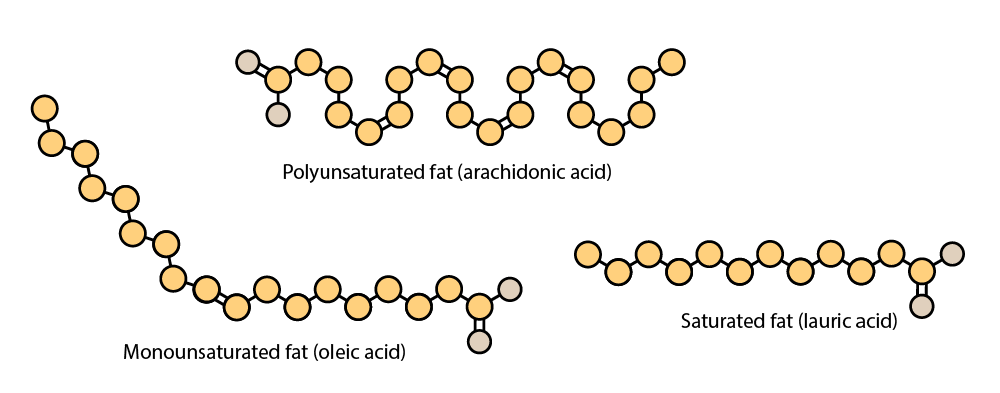Health & Wellness, Skin Care Health
Unpacking Fats: Understanding Types, Chains, and Categories
Today, I’m diving into the topic of fats—essential components that can be both beneficial and harmful in our diets and skincare products. To truly grasp their significance, it’s important to break fats down into their different types. This will be the first part of a two-part series. In today’s discussion, I’ll explore the various categories of fats and their impact on both our diets and skin. Next week, we’ll delve deeper into individual fats, examining their fatty acid profiles, and weighing their pros and cons.
Interestingly, fats share the same basic elements as carbohydrates: carbon, hydrogen, and oxygen. However, the proportion of these elements differs significantly, giving fats (also known as lipids) a longer and more complex structure.
Fats are composed of building blocks of fatty acids (FA). There are three major categories—saturated, monounsaturated, and polyunsaturated. These classifications are simply based on the number of hydrogen atoms in a fatty acid. Saturated fats are often referred to as “bad” fats when it comes to food, and are solid at room temperature (think about the fat on a big slab of sirloin). The unsaturated fats—mono and poly—are thought of as “good” fats for food intake and generally are liquid at room temperature (cooking oils like olive oil and avocado oil).
Saturated fatty acids are found primarily in animal products (think beef, veal, lamb, pork, ham, and dairy products). There are three vegetable products in this saturated fat category: coconut oil, palm kernel oil and palm oil.
The liver uses saturated fats to produce cholesterol, and excessive consumption of these fats can significantly raise blood cholesterol levels, particularly low-density lipoproteins (LDLs), commonly known as “bad” cholesterol. While cholesterol is often seen in a negative light, it’s important to remember that it plays vital roles in the body. Cholesterol is essential for cell-to-cell communication and is a precursor in the production of Vitamin D. However, the issue arises when we consume too much saturated fat, leading to elevated cholesterol levels, which can contribute to heart disease.
Polyunsaturated fatty acids (PUFAs) are mostly plant based and are found in greatest abundance in corn, soybean, safflower and sunflower oils. Certain fish oils are also high in polyunsaturated fats (salmon, halibut, cod, tuna, etc.). PUFAs can help reduce over-all cholesterol levels but that includes the good cholesterol too (high-density lipoproteins, HDLs).
Monounsaturated fatty acids are found mostly in vegetable and nut oils such as olive, peanut and canola. Unique to monounsaturated fats is their ability to reduce bad cholesterol levels without affecting good cholesterol. This is why consuming these types of fats are so beneficial. They also provide vitamin E, an important antioxidant vitamin.
Fatty Acid Chains and Their Lengths
Fatty acids in fats are classified by their chain length, determined by the number of carbon atoms they contain. These chains can be short, medium, or long. Fats with short and medium chain lengths are more likely to be used as energy rather than stored as fat, though this ultimately depends on your total caloric intake for the day. If you consume more calories than your body needs, even these fats will be stored. On the other hand, long-chain fatty acids are much more likely to be stored as fat.
Coconut oil got a bad rap in the 80’s and 90’s because it’s an unsaturated fat (unhealthy fats). Turns out, coconut oil is mostly made up of medium chain triglycerides (MCTs) so it’s not as unhealthy as once originally thought. And coconut oil is great for hair and an excellent cleansing agent in laundry detergent and in handmade soap making.
A Heart Healthy Exception Among Long Chain Fatty Acids
Omega-3, omega-6, and omega-9 are unsaturated fats that are well-known long chain fatty acids. Unlike most long-chain fatty acids, omega-3 is considered heart-healthy. There are three main types of omega-3 fatty acids: EPA (eicosapentaenoic acid) and DHA (docosahexaenoic acid), found mainly in cold-water fish like salmon, and ALA (alpha-linolenic acid), which is abundant in plants such as flaxseed, soybeans, canola, and certain nuts and seeds. Although salmon is classified as a fatty fish, its high content of omega-3 fatty acids makes it beneficial for your health. Each of these omega-3s plays a vital role in promoting overall well-being, both inside and out, and could easily be the subject of an entire paper due to their significant benefits to the human body.
I’ll further breakdown the different types of FAs in next week’s newsletter (i.e., stearic acid, oleic acid, palmitic acid, etc.). Some FAs are better for skin than others and some can even disrupt the skin’s protective barrier making you more vulnerable to environmental factors. ☹
I hope you’ve found this informative and helpful. It’s interesting that the same fats we consume we also use on our skin in various forms. Just like with food, some fats are better for us than others while offering various benefits.
Now as you go about your day see something that inspires, uplift with your words, and change the world with your actions. There’s so much we can do to uplift, inspire, and make a difference in a world that has grown more chaotic. Lead with love and gratitude. ![]()

